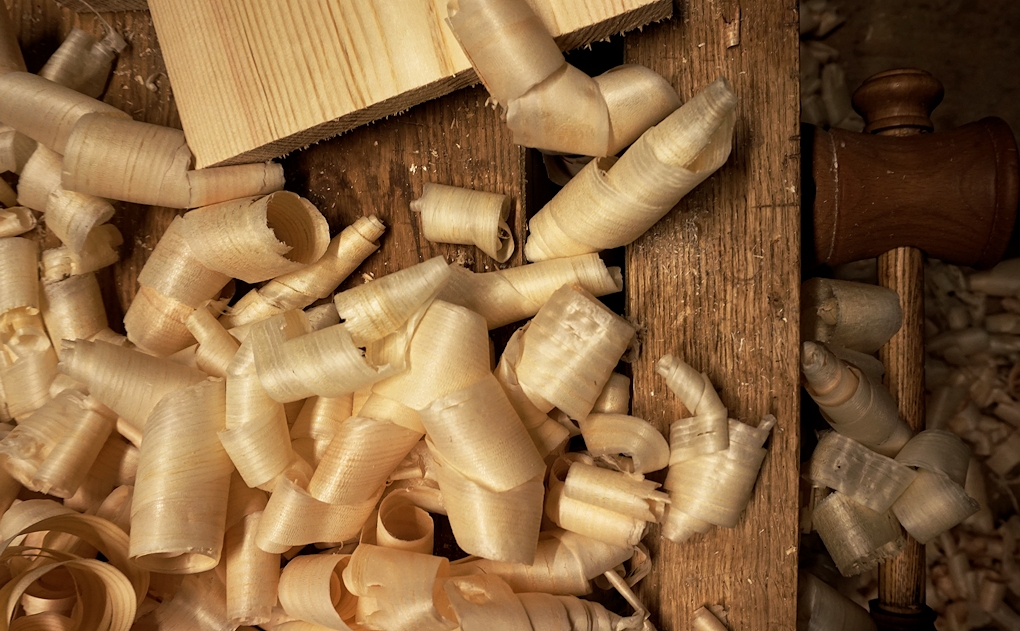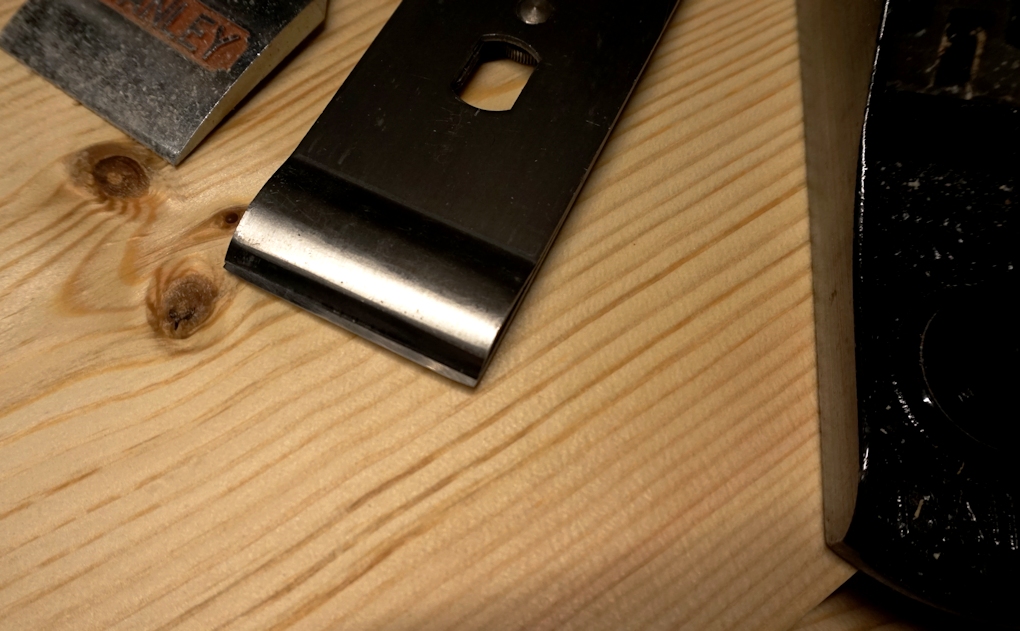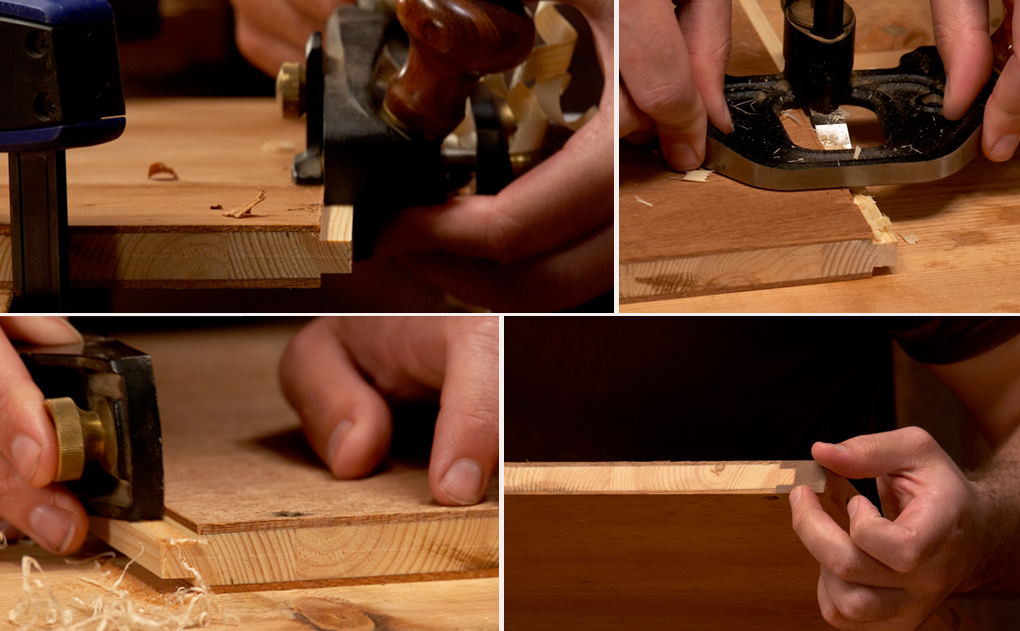Since ranting about using the cap iron for dealing with tear out, the question ‘why do you only use it when smoothing?’ comes up a lot.
This question is best answered by me asking you to go and do something.
Go and set your hand plane up to take a shaving with the cap iron nice and close to the edge as we discussed, so it’s actually doing something.
Take a shaving with the grain on a fuss free piece of timber. Begin the cut as normal, but once started take your hand off the front of the plane, only push from behind and give no downwards pressure.
Now a comparison shaving.
Use the same plane but this time with the cap iron right back out of the way (1/8″ or more). Aim for the same depth of cut and of course both times ensure a sharp iron.
Repeat the shaving and once again take off the front hand so the plane is only being pushed forward and not down.
Did you notice the difference? Try it a few times more if you didn’t.
Here’s what you should find:
Planing with the cap iron set is hard work.
Normally a plane will pull itself down in to a board as we take a shaving, which means we only need to push forwards. Close cap irons remove a lot of this benefit and without applying downwards pressure it will probably skip (something I see people suffering with a lot). This need to add downwards pressure together with the cap iron’s effect on the shaving, adds friction, so all in all it becomes a bloody hard job. This is magnified on thicker shavings.
Like four wheel drive, the cap iron is tremendously useful in the right situation, but turning it on for anything else it’s inefficient. With four wheel drive this will hurt your pocket, while inefficient planing affects you.
To do a good job we have to learn to be efficient. Tear out isn’t the only battle that we have when planing and a bigger one will likely be fatigue. Getting knackered makes us sloppy and that’s a big cause for a rough job.
Don’t confuse that with meaning that it should never be used in anything other than smoothing, but those scenarios are niche and wouldn’t be general run of the mill stuff.



![Which Saws Are Best For Ripping Thick Stuff? [Video]](https://www.theenglishwoodworker.com/wp-content/uploads/2022/12/what-hand-saw-is-best-for-thick-rip-cuts.jpg)
![Bench Top Edge Jointing [with Video]](https://www.theenglishwoodworker.com/wp-content/uploads/2022/10/bench-top-edge-jointing-video.jpg)

![Quick Homemade Clamps – Small & Large [with video]](https://www.theenglishwoodworker.com/wp-content/uploads/2022/08/how-to-make-your-own-woodworking-clamps.jpg)
Excellent post, Richard 🙂
Cheers Paul 🙂
If you’re correct, (and I have no reason to believe otherwise), this is one of the best pieces of printed advice I’ve seen in quite a while. When I was flattening my oak bench top, the blisters on my left hand were pretty bad. Admittedly, they probably would have blistered in any event, but perhaps not as badly with your advice. I will definitely try it out.
Peter
Chicago
Hi Peter,
Bugger, a blistered hand, that sounds pretty rough. The only real pressure a plane should put in to your hand (lets say you’re right handed) is across your right hand palm and between your thumb and index finger, where the back of the handle sits. Hopefully this will go someway to help, I’d be really interested in your findings.
Another gem! Thanks for great advise. I have had no formal trainng, so information from experienced people is the way I learn. I will start on a workbench in a few months.
Cheers John, the sad news is I doubt any of this would be in formal training these days. It’s good to hear you’ll be building your own bench, I hope we’ll get a picture!
Yummy, learning by experiment.
This is a good example of what you wrote in the post of January 15th. “With physics there’s a general rule – you don’t get owt for nowt; there’s always a compromise.”
Very simple physics in this case. If you want to keep the fibres pushed down and broken forward, the fibres push the plane up and backwards.
Yep, pushing through fatigue usually means doing the same work again tomorrow.
Hi Jasper,
With woodworking, and I think a lot of things in life, it’s about knowing what you need and what you can compromise on. Planes are great examples, they’ve got it all, but you can’t have it all at once!
Superb! What a rational way to describe, and demonstrate, the mechanics. This kind of teaching is so much better than the “do it because I told you” style of teaching.
Much appreciated!
Have I seen your face Mr Easton on another site, I too like to get another opinion and Richards is very interesting
Regards John
Thanks Robert,
As long as it makes sense… ish, I’m happy!
This wasn’t the explanation I was expecting.
I was expecting, “Because when you’re roughin’ ya don’t bloody need it!”
But alas, no. Richard surprises again.
Ha ha, in mark I of the post that was definitely in there… word for word!
I’ve been reading the blog and watching the videos for a while now, if you couldn’t tell 😉
But at least this makes me feel better about backing the cap iron off the edge 1/8″ on my metal fore and jointer. That’s not why I did it, though. I just did it because I didn’t care about the finish they left. Roughin’ is roughin’, smoothin’ is finishin’.
Now I understand! Let there be light.
No setting is the best for every situation.
Great post, fantastic info.
Thanks Ricardo, absolutely right. Even just changing species of wood can require slight changes to your tool set up or approach. It doesn’t take much piddling about to get the experience needed to know what best suits your situation.
Very true. One of those things I don’t think about, but have felt the effect of, and never really consciously handled appropriately.
I’m not sure your explanation would resonate with some of my neighbors as I presently reside in a place where everyone besides me seems to think that four wheel drive is an absolute necessity, and they don’t understand why I don’t get stuck without it yet they do with it.
Ha, everyone’s got a Case Quadtrac around me… I feel left out in my Panda!
I think that’s half the battle with woodworking, it’s trying to observe the effects you feel and find a reasoning for them.
Cheers.
The low weight of the Panda should help you. With less inertia, you need less grip. I used to drive a Renault Express/Rapid – also lightweight, flimsy by today’s standards – it was quite easy to handle in mud and snow.
So are you saying it’s easier planing if i move the cap back?
Effort wise yes, at the potential cost of the finish. So it’s best out of the way for the bulk, and then utilise it strategically when needed.
Richard,
Probably the reason I enjoy my single iron woodies so much!
Paul
Absolutely Paul!
It’s always nice having the option, but when you’ve got multiple planes anyway life’s just easier when they’re dedicated.
A very interesting explanation of effect with different settings?? I shall try later with
interest.
Thank you Richard……best John
Thanks John, I do hope you give it a try. Playing around’s always the best way for getting a feel.
Cheers.
Very interesting explanation of the effect of different settings…….I look forward to trying it out
Thank you Richard……best John
Tried to comment twice and rejected …..so I will unsubscribe from you site
Sorry to hear that. If you’re new to commenting or haven’t commented in a while they have to go through a manual approval process – it’s a spam protection. They don’t get rejected, it’s just a slight delay before they come on.
Hi Richard
Thanks for sharing, love your style. just out of interest do you believe that along with the cap iron the steel that the blade was forged from also makes a difference. The Japanese use many different steels ,matching steels to the tree and grain structure. Originally only using a single iron to plane. All that changed was the mouth size and pitch of the blade.
PS I’m off to have a play.
cheers Andy Ryalls
Hi Andy,
Very interesting, Japanese woodworking absolutely fascinates me but I kind of feel like a need a spare life to really give it a go!
To a slight degree I think yes, but I think you’d have to be very knowledgeable of the material properties and practiced with them to really maximise the benefit or get any notable difference.
Using a brittle iron and swiping hardwood would be a sod when half your cutting edge is snapped off. Saying that I do prefer O1 steel over A2 any day of the week and I do believe I get better results, so I suppose it’s worth some thought.
Thanks for the comment- nice and thought provoking.
This is an interesting topic one that landed me in a whole lot of mess and $60 out of pocket for a new cap iron. What I’m about to tell you probably is well known to you already but I have seen the results which astonished me. If you hone a very small secondary degree bevel 45 – 50 deg on the chipbreaker you can plane even against the grain on the most gnarliest wood you can find with zero tear out. I have seen it done and was amazed so I tried it out and I went overboard and shortened the cap iron which resulted in the blade not protruding through the mouth to take any shaving at all. I believe I shortened it by an 8th and this is on the modern chipbreaker. I haven’t tried it again but I would like to.
Hi Salko,
I’m sorry to hear your devastation! But you really must bite the bullet and set one up again, I’m not sure if you’ve seen the setting up videos that we did (try the link towards the top of this post) they’re pretty boring, but show a pretty bullet proof way of setting a cap iron for controlling tear out in the way you describe. I’d try next time on something cheap though just in case!
Hi Richard,
I’m new to the blog after finding you on YouTube. Great videos!
I only have 1 plane and it’s a smoothing plane. I can adjust the mouth opening on it from almost closed to widely opened.
What effect dies this have? I played with both settings and didn’t really notice anything.
Thank you!
Pat
Thanks Pat,
On a good plane that’s got a very well fettled mouth, you can close the mouth up as a fairly reliable way of controlling tear out – it keeps the wood pressed down to itself ahead of the cut. And of course you open the mouth to let thicker shavings through for heavier work. Generally on most planes I find it best if you leave the mouth somewhere in the middle and rely on the cap iron for smoothing, and pull the cap iron back for roughing. We’ve done some videos covering the basics of the cap iron, if you haven’t seen them there’s a link at the top of this post. If your plane hasn’t got a cap iron then just let me know what kind of plane it is.
That’s a very basic overview.
Cheers,
Richard
Sorry, you are wrong Richard! 😉
The trick is to set the capiron at an appropriate distance. Too close and planing becomes real hard work. Too far and it isn’t helpfull.
Especially in the try-plane fase of dressing a board, the capiron is very valuable. Sure, don’t set it too close, but set it close it enough that it prevents disasters, deep tearout that takes ages to remove and makes you go beyond layout lines. On a troublesome board this won’t give you a blemish free surface, that’s the smoothers job, but it sure beats deep tearout.
A capiron beveled to no more then 45 degrees, set at an appropriate distance from the edge is really not so bad in the aspects you mention. Extra resistance makes you feel that the capiron does its job. If you really want to know what hard work is, try a plane with a high cutting angle.
Hmm… so ‘wrong’, yet you agree. A cap iron that’s doing something adds resistance.
Not everyone’s aware of this and it’s an essential mechanic to understand.
I did add a wink.
I had the feeling you were “throwing out the baby with the bathwater” in your statement that the capiron is only to be used with the smoothing plane and the rest of its use is a niche. While I find the capiron tremendously helpfull in prepping a board, after knocking off the rough and high spots with the jack plane, and starting to make things straight and true with a tryplane.
And it sure adds resistance, just not enough to be a problem. When the board is easy, you can set the capiron wherever you want and indulge in the ease of working. But when there are knots or swirls or whatever, it is just a good idea to prevent deep tearing early in the game.
If it’s adding that much resistance, it’s too close. In about 4 years, I can remember having to set the cap iron on a jack plane twice. Never close other than that – certainly the wood will tell you if that’s necessary.
Reasonably close, but not that close on a try plane will leave less work with a smoother (which means you can get closer to a mark with a jack) and then wherever it needs to be on a smoother so that it’s engaged on a thicker smoother shaving but not a thin one.
I do not have significant cap iron resistance with a try plane unless the shaving thickness is a hundredth or so.
(these are medium hardwood numbers, never checked with softwoods because they don’t usually need much assitance from a cap iron).
Hi Richard . . .
a few blogs ago you said you were going to do a short video on sharpening the plane iron. I have been experimenting with a gradual curve across the whole blade instead of rounding just the edge. I would be very interested in seeing how you sharpen your plane irons 🙂
p.s. now that your going to be back on the videos, any chance of a follow up to ‘preparing to make a wooden plane?
Hi Rashid,
We’re getting there with new video content and once we get going we hope there’ll be a steady stream. The hand plane is now in production.
Cheers.
Great piece if advice mate. Would never have thought the cap iron would have an affect like that. but then again high angle planes are harder to push and the cap iron is sort of acting as increasing the angle when set close to the edge. Then again I may be wrong.
Love you blog and you videos. Keep them coming
Cheers Kyle
Down under
Richard,
Enjoying your posts, planes have always been a mystery to me.
Been digging around, discovered that, my Great Grandad’s woodies were single irons.
My grandads had bee modified wit shims to adjust the mouth on smoothers, as a machinist, I replaced the blades wit thicker ones, to have same effect?
Paul